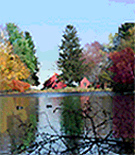|
|  |
"Black Joe's Pond":
Narrative Poems Emerging from the Lives of
Lucretia and Joseph Brown and
Those who Gathered at their Tavern, 1794-1834
by Maryclaire Wellinger
The Chapbook includes 8 major poems and includes numerous color illustrations, prints of original watercolors by the author. Although "Black Joe's Pond" is a work-in-progress, the Chapbook is available to purchase, available here from Rosewater Press for $25. It is printed on high-quality acid-free paper. The Great Blue Heron image below is the cover illustration. "Black Joe's Pond" Chapbook Cover Illustration Great Blue Heron, Black Joe's Pond, Indian Summer, 2001
original watercolor by Maryclaire Wellinger
Great Blue Heron or tmgwatignej (Pronunciation: dêmm·kwa·di·gê·nech. Dialect: Listuguj of the micmac tribe)
Welcome to the cosmology of "Black Joe's Pond." By the grace of poetry, Lucretia and Joseph speak to us in the first person -- as Common Man and Common Woman who live close to the earth and the sea. By the grace of poetry, Lucretia and Joseph speak to us as African-Americans whose tavern provides a gathering place for North Shore blacks. Their story provides a way into the world of African-Americans and Marblehead fisherfolk in the New England of that period.
By the grace of poetry, they come to life, as do those who gather at their their tavern, including Daniel the Shipwright, who " . . . builds a sound vessel . . ." for Stargazer, a fisherman from Cornwall who sailed to Marblehead by way of the Canary Islands, and Rose " . . . who would run up the hill to Joe's tavern/ in her red leather boots and she would dance / upon the soft sand Joseph throws/ down on the wooden floor boot soles pushing/ through sweet pine air,/ spinning like a pitched penny to the reels/ of Joseph's fiddle and panting/ to the the rythm of wave-breaths/ exhaled on the beach/ the Song of Yankee Doodle . . . ." And fisherfolk and mariners " . . . as they come rolling up the hill hips swaying/ with the muscles' memory of a heaving deck/ for games of chance, Barbados rum, Joseph's/ homemade ale and the sweaty dance/ . . . Sinker and Towline, Onion Eye and Eaglebeak, Dogtray and Clambelly . . . and Black Quashi from Cape Verde. "
On this webpage, let's go on a ramble together at "Black Joe's Pond" along the footpath Lucretia Brown describes:
" . . . I walk the pond's footpath hemmed thickly
with bright color, the purple green and gold
of Birdsfoot Violet, Fiddlehead Fern, and Marsh Marigold,
It is the rose that fills the crevice in the rock
and the hollows of my heart with her {Lucretia's mother} light . . . "
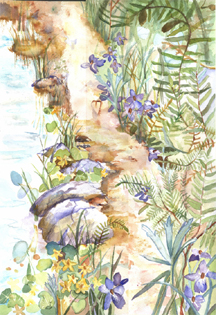
Lucretia collects the petals of wild roses growing on Gngerbread Hill to make rosewater, a delicate flavoring in cakes that she bakes at the tavern and sells to Marbleheaders. (Lucretia's wedding cakes are renowned.) We pass Joseph preparing for Winter, mending a stone fence. Lucretia's beloved adopted daughter, her grandniece, young Lucy Ann Reed Brown, is with us, and we guide her way. In the very air, in the winds that caress the surface of the pond, in the reflection of the clouds upon its surface, live the presence of those souls who have passed on
" . . . of fishermen who fished here,
casting their own light,
returning to the sun its own strength,
filling up the pond with the copper brightness
of pennies they once pitched here,
gilding the mud-leafed bank . . . "
Lucretia tells us of how she is aware of the presence of the spirit of her mother, who was born in African and who was a slave and then housesevant to Captain Samuel Tucker and his wife Mary Gatchell. Lucretia is aware of her mother's spirit in this way:
" . . . Fruit trees Joseph planted whisper her soft
syllables of African talk. As I walk
mother is blessing me in her old tongue
recalled in the muted keening of mourning doves . . . "
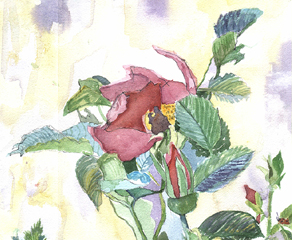
Before we move any further into the poetry,
let us begin with a blessing:
Now as we move into these poems
focus on the gentle blurring
of the light's love objects
on Joseph and Lucetia Brown
and those who gather at their tavern,
on their souls' presence.
By the grace of poetry
take the measure of space
between Earth and Sky
one-ing yourself with the light
through those who dwell and build
and think
at "Black Joe's Pond."
Receive the light
as it rises and sets
in loving rhythm each day
within your own soul's dwelling place. "
(from the "Prologue") Indian Summer, November, 2002
"Black Joe's Pond"
Marblehead, Massachusetts
photo by Maryclaire Wellinger
" . . . Inside the ellipse of "Black Joe's Pond"
fishing in the shallows beyond this stone promontory
is the Great Blue Heron
who comes to us when the sun's pollen
of morning light is descending,
not as sentinel alert for some predatory movement,
but as the pond's luminary
with the light of Joseph's spirit in-dwelling.
Migrating on a path
towards the longest light,
it flew to us.
Resting though aware,
the bird bears witness eyes moving
with the serenity of constellations,
seeing in the sailing clouds the determined
motion of subatomic particles,
reading the cloud's reflection
in the iris of the hill's eye
as the inner excitation
of an atomic system by radiation . . . " "Black Joe's Pond" in Winter 1995
watercolor on graphite
*********************
|
 |
|
Genesis of the Work
Our "ramble" begins here. On an Indian Summer's day in November 1991, at "Black Joe's Pond," in Marblehead, MA, the Great Blue Heron appeared near this stone before me. Standing with such stillness, the bird's luminous reflection on the water's surface appeared with great clarity and the pond itself was made to appear infinite in its depth. 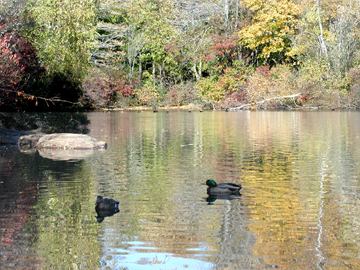
As I gazed across the pond, the saltbox structure was bathed in soft afternoon sunlight. (See photo, right.)
The pond is a rich bouillabaisse with schools of carp and a multitude of fat yellow frogs. One was croaking with its head poking above the surface of the water, and I looked up to see a Great Blue Heron, standing in perfect stillness near a rock in the shallows about five yards away. Each year, for a month, we are blessed by the presence of this individual Great Blue Heron who is migrating south for the winter. Throughout its life, a heron will fly to the same pond along its migratory path, so its autumn visitation is a celebratory reenactment each year of one unique aspect of Nature's sacred liturgy, the great cycle of seasons.
My own human participation in the "marvelous and surreal" required that I be open, that I empty myself, in order to recognize my Spirit Animal, to receive my Muse, to "hear" in the deepest poetic sense, the Voice of the Great Blue Heron " . . . with the light of Joseph's spirit in-dwelling. . .". This deep "connectedness" I felt on a cellular level. Each cell in my being realized the Great Blue Heron in this way, which I can only describe in poetry, and which would become the sixth poem in the latest version or printing of the chapbook, "Black Joe's Pond." 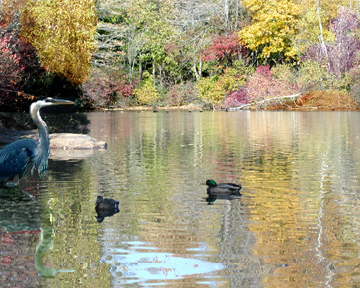
I returned to my rock and the heron had not moved.
" . . . The bird is breathtaking. I have heard
the Great Blue Heron when it rose
from its stone perch out of water break
the tension on the surface as it flew,
dipping down into the pond's mouth
with the splashing sound
of rain on an open sea .
I have heard the heron's vaulted
hydrannasic wings crack the air
in a slow rhythmic beat,
charting the pond's breadth . . ." 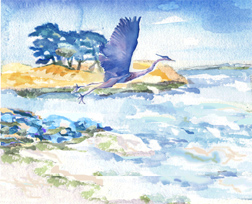
". . .
Burning off the pond's velvet face
morning mist offers up
the palpable softness
sweetness and power of opule nt violets
and plush blackberries.
Beneath this supple veil
through the dark, deepset eye
of "Black Joe's Pond,"
the hill reads our gestures.
Bullfrog turtle muskrat
and sparrow hawk raccoon
pheasant and red fox
move about the pond through time,
observing and observed."
Pitching Coins into the Pond,
'Lection Week, May, 1814
| Pitching Pennies into th Pond, 'Lection Week, 1814 |
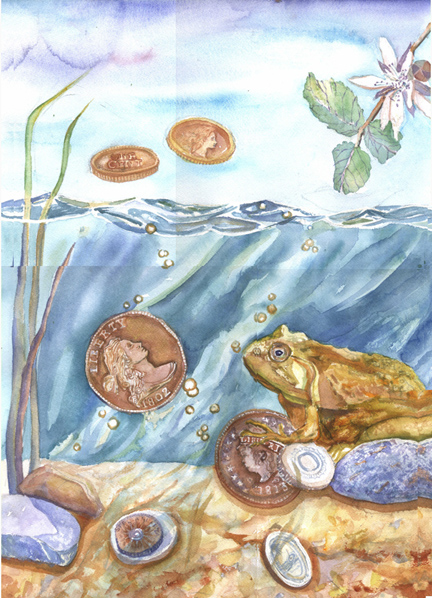
|
| watercolor by Maryclaire Wellinger |
|
 |
|
|  |
The Great Blue Heron as the Poet's Muse.
My Encounter with the Great Blue Heron was a transformational experience which would change the course of my life. The Great Blue Heron was the embodiment of my Poetic Muse, or in Native American terms, my Spirit Animal, whose presence is still with me.
I was sitting on a large, flat rocky ledge on the southwestern edge of the pond's ellipse, just off the footpath which circles this strikingly beautiful glacial kettle pond. I was writing poetry. One bend of the pathway below me, seated on another rocky ledge, were two young boys fishing, and I could hear them softly speaking to each other. 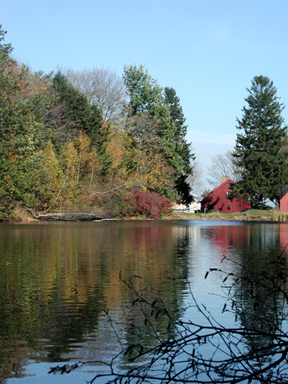
"Cracked Open".
As the heron remained perfectly still, linear time was suspended. I felt a keenly heightened awareness -- sounds were received by my inner ear as separate and distinct and there was no confusion of sound . . . the frogs croaking, the carp swimming near the water's surface, and the two boys talking. I heard one say to the other "Look at that bird -- isn't it magnificent!" unusual language for 12-year old boys. Then a splashing sound and their voices grew louder, more high-pitched. I left my rock, walked the footpath around the bend to where they were seated. They had a caught a carp and were struggling with it -- a beautiful creature, probably 3 or 4 pounds. They said, "who are you? where do you come from?", and I answered: "Oh, I'm a poet sitting on that rock and I looked up to see the Great Blue Heron." One boy was holding the carp and then he gently placed the fish into my open hands. In one gesture, I raised my arms upward and the silver carp glowed irridescent and its skin was shimmering in the sunlight emanating rainbows of color. "It's too beautiful to keep. Let's put him back," said one boy, and the fish was returned to the pond's waters and was gone.
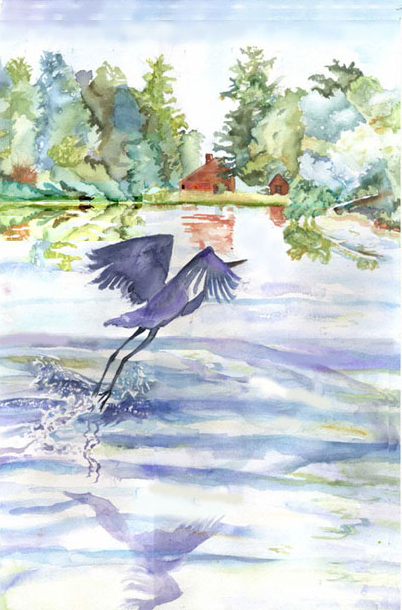
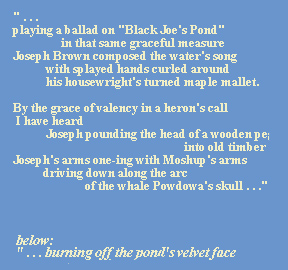
| "The Pond's Velvet Face: Morning Mist" |
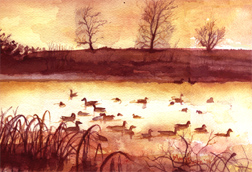
|
| watercolor by Maryclaire Wellinger |
watercolor by MaryclaireWellinger
More selections from the poems to be published. This page is under construction. and thanks for your patience . . . M-C
lampo'q-- bottom of lake
(pronunciation: lam·poohk;Dialect: Listuguj in MicMac)
So, the frog might say, as he catches his liberty penny, in Micmac--"Etlwejituap na suliewei lampo'qigtug".
I found that money on the pond's bed.
coin-- suliewei (pronunciation: su·li·e·wey; Dialect: Listuguj in MicMac)
frog-- sqolj (Pronunciation: ês·hkolch; Dialect: Listuguj) |
 |
|
|
|
|
"Black Joe's Pond in Moonlight"
an original watercolor by Maryclaire Wellinger"
In Winter, there is a special beauty . . . faces emerge from patterns on the ice , reminding us of the fisherfolk who fished here
". . . casting their own light/ returning to the sun its own strength . . .)
| "BLACK JOE'S POND" IN WINTER |
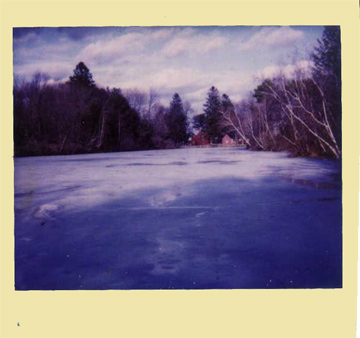
|
| PHOTO BY MARK J. FISHER, 1996 |
Photo by Mark Fisher, March, 1996
Biographies of Lucretia Thomas Brown (1773-1857)
and Joseph Brown (1750-1834)
I am writing the biographies of Lucretia and Joseph which will be published here shortly. Their rich and eloquent stories unfold within the larger context of the African-American experience in the colonial and postconial periods in Essex County and New England. Their roles in the Marblehead community were defined in a formal way as tavernkeepers, and I will reference two excellent articles in the Essex Institute quarterly which elaborate on the social significance of the tavernkeeper, the life of the tavern as a social center in 17th & 18th century coastal New England communities, and a discussion of the high proportion of female tavernkeepers. 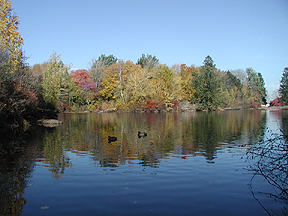
With a focus and intensity that was sustained for a long period, I began to write the poems immediately after my experience at "Black Joe's Pond" in November of 1991. All through that Winter and the Spring of 1992, when I wasn't actually writing the poems, I was at the Abbot Library in Marblehead or the Salem Library or at the Phillips Library at the Essex Institute to research and read -- birth and death records for Marblehead and Salem and Martha's Vineyard, the two important Marblehead histories, Rhodes' work and "The Spiriit of '76 Lives Here: Marblehead" (Chilton Book Company, 1962) by Virginia Gamage & Priscilla Lord and, and then other secondary sources by historians who focused on the African-American experience during the colonial period. And I found published excerpts from an Elizabethan explorer's account of the whale hunt by the aboriginal people of Martha's Vineyard (now called the "Wampanoag tribe"), which evolved into the poem regarding Joseph's ancestry, his Pawknawku father and African mother, and describes te whale hunt off Katama and importance of the whale to the people. That was a starting place.
| An unidentified 19th c. Island Indian fishing |

|
| in the traditional manner, circa 1890 |
My essay on the historical background to "Black Joe's Pond" will also also include information about the African presence on Martha's Vinneyard; Joseph's father was a Wampanoag Indian and his African mother would most likely have lived with the Wampanoag people in Gay Head, The rich culture of these aboriginal whale hunters informs the book, and especially their mythology. The principal gods, Squauanit and Moshup, and their creation stories would have been part of Joseph's life, and their presence is felt in the poetry. Certainly, Joseph would have been taught these stories.
An anonymous 19th century Island Indian fishing
in the traditional manner (photo circa 1890)
Simon Johnson (1794-1880), the last "full-blooded"
Indian known on the Island when this photo was taken.
Paul Cuffe (1759-1817), was a more famous contemporary of Joseph Brown, and was born on Cuttyhunk Island. Like Joseph, Cuffe's father was Wampanoag and his mother a former African slave. The portrait of Cuffee (right, below) was rendered during his lifetime, and suggests what we might imagine Joseph Brown might have looked like.
| Portrait of Paul Cuffe (1759- |

|
Cuffee was a successful seaman, merchant, Quaker preacher and founded an interracial Quaker school. An activist, throughout his life, he sought to strengthen the legal position of blacks in the United States.
It is more difficult to imagine or recreate the gods and stories of Lucretia's African-born parents and Joseph's African mother. Most New England Africans were taken as children from West African villages. So memories and knowledge of their African culture including their religious beliefs, was most likely seriously limited. But there are hints and guesses in first person accounts by New England blacks born in Africa of the cruel impact personally of this loss of culture.
This loss of connection to one's family and culture of origin was revealed in one poignant reminiscence by Colonial New England 's remarkable woman poet, the African-American Phyllis Wheatley (1753-1784). Born in Africa, the child who would be known as Phillis Wheatley was brought to Boston in 1761 to be sold on the slave market. The child was purchased by the Wheatleys, a prominent Boston family. Early on, Phillis showed signs of remarkable intelligence, was tutored by Mary Wheatley and began to write extraordinary poetry as a young woman. Her first poems were published in the late 1760's and in 1773, her first book, Poems on Various Subjects, Religious and Moral, was published in London. In one rare reference in her poetry, Phyllis Wheatley ) wrote of racial injustice in this memorable, deeply felt lyrical line
" . . .Some view our sable race with scornful eye . . 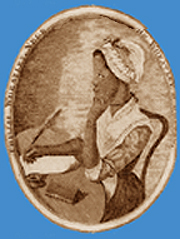
Phyllis had been stolen from her village when she was only seven years old, and so had little memory of life with her family and village of origin. But she did recount one memory of her mother . . . every morning, her mother would go outside the door of their home, face the sun, and pour a libation of water from a special gourd in a prayer of thanks to God. So we can intuit that Joseph's mother, and Lucretia's mother, may have retained similar fragments of their families and culture, whisps of stories and feelings and impressions which they recounted to their children.
Where is Lucretia Brown Buried?
By the Summer of 1992, my curiosity led me to find out where Lucretia Thomas Brown was buried. Joseph Brown's grave on Old Burial Hill was clearly marked with a headstone that states his birth and death dates and charcterizes him as " Marblehead's 'Black Joe', a Revolutionary Soldier & Respected Citizen ." So where were Lucretia's remains buried?
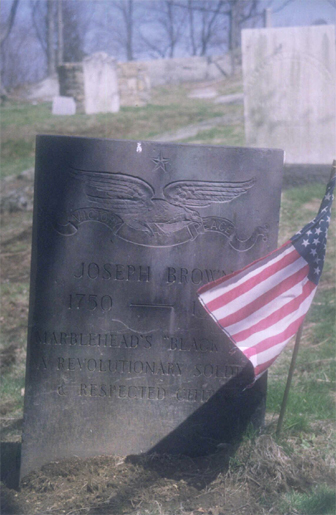
Because Joseph was 24 years older than Lucretia, he died in 1834 decades before she did . A local author of told me that in her own research, she had understood that Lucretia would often visit Joseph's grave. Her route, according to Dorothy, was to walk from Gingerbread Hill, down the slope, across the meadow then up the slope towards Redd's Pond and Joseph's grave along a narrow footpath known as "Gingerbread Lane," which existed like it was in Lucretia's time --an unpaved footpath -- until recently.
I talked about this mystery -- where is Lucretia buried? -- with my artist mentor & teacher, Ronald Kulloway, and in the Fall of 1992, Ron introduced me to Betty Hunt, then the Director of the Marblehead Historical Society. Betty was enthusiastic and quite helpful. Betty Hunt thought Lucretia might have been buried in the same gravesite with her husband, and suggested I look through the Historical Society files for the documentation generated by the Daughters of the American Revolution. Earlier on in the century, the D.A.R. had documented every gravestone on Burial Hill. I found that the earlier gravestone which marked the burial site cited both Lucretia's & Joseph's names with the birth and death dates for each of them.
Therefore, Lucretia is buried next to her husband, and righfully so, as one would logically expect. But why in our own contemporary culture, had Lucretia been unconscionably, officially "disappeared" ? Was her life as a woman not considered as significant as her husband's? Perhaps because she didn't officially carry a musket in Captain Fettyplace's regiment at Fort Sewall for six months in 1775, as Joseph had, when Lucretia would have been only two years old? This situation is an example of gender bias and illustrates how the interpretation of historical figures often reflects more about the values and belief system of our contemporary culture than it does about the historical period.
So in our lifetime, Lucretia's presence has been erased and her significance to the community diminished. Yet, during her own lifetime, Lucretia Thomas Brown was a woman of significance to her contemporaries; she manufactured rosewater, was a professional baker, and she carried on the work of the tavern long after Joseph's death -- she was a successful "entrepeneur," -- though not in a strictly mesurable financial sense -- but meaning that her role in the community was significant and recognized. Lucretia was renowned for her baked goods, her wedding cakes, and was also, as the gravestone says about Joseph, "a well respected citizen." She was known as "Aunt 'Crese" in her later years and she attended the weddings for which she baked her cakes. I was told by oldtimers, Marbleheaders whose forefathers had been fishermen for generations, that Lucretia's reeipe for gingerbread, the "Joe Froggers" which are baked and eaten by many of us to this day, were used as hard tack when they went out on fishing voyages -- their wives baked them because they didn't become soggy or go bad during a long trek.
Lucretia's Firkin watercolor on graphite 2001
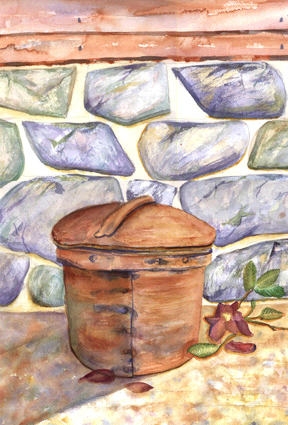
above: My painting illustrates how Lucretia manufactured rosewater.
After she collected the petals of wild roses growing on Gingerbread Hill,
and along the shores of Doliber's Cove and Little Harbor, she
would ferment them in a vessel for a period . . . either a clay crock or
a wooden vessel, known as a "firkin". Perhaps Joseph fashioned this for her.
The consequences of editing out the existence of Lucretia at her gravesite are subtle but profound. How are contemporary women in our community affected if female historical figures are portrayed as nonexistent or their real accomplishments diminished? I believe this type of revisionist history creates a distortion in the community psyche.
As I have continued my research into the lives of African-Americans and women in this period, it is clear that we reveal more about ourselves and our contemporary culture's values by the way in which we interpret the lives of Lucretia and Joseph. Sexism, racism, elitism and all the "isms" are deeply embedded in all of us. It was a lesson well-learned. Thanks to the the Town Fathers' extraordinary oversight and Betty Hunt's expertise and knowledge, I had learned an important lesson.
As one who creates historically-based poetry and paintings, I must be acutely aware of my own distorted lens. Artists who create historically-based work must be very thoughtful regarding these issues, and be very careful in their scholarship, and especially must guard against projecting their own distorted assumptions, misperceptions and projections onto the historical figure who is their artistic subject. The following letter was my way of saying "thank-you" to Betty Hunt for her assistance early on in my research.

Performance Herstory of "Black Joe's Pond"
The first major performance took place locally at a sell-out event entitled "UNDER ONE CANOPY" sponsored by Marblehead's "Coalition for Diversity" at the Unitarian Church on Saturday evening, March 6, 1993, only one day after a blizzard dumped several feet of snow. It was bitterly cold, and there were mountains of snow everywhere, but despite the difficult weather, hundreds attended the performance to support the goals of the newly formed coalition, to raise awareness of issues on race in our community and to create practical strategies to fight racism. At the performance, I sold my first edition of "Black Joe's Pond" which included an essay on the research I was engaged in on African-Americans in Essex County during that period, and a map of the Underground Railroad in Massachusetts. I wanted to share my knowledge of African-American herstory and history, the little bit I had learned, with the community regarding this fascinating chapter in colonial and postcolonial Essex County.
A second notable reading was given at Sunset in the King Hooper Garden of The Marblehead Arts Association August 13, 1995 with Stephen Hemingway , a distinguished African-American writer and television producer and close friend; Betty Hunt, Virginia Gamage, and then Exeutive Director of the Marblehead Arts Association Nancy Ferguson were in the audience. Again, under the aegis of Rosewater Press, I published a revised and updated edition of my chapbook, and for two years, it remained on sale in the Gift Shop of the King Hooper Mansion.
On Sunday, February 13, 1999, the poems comprised the liturgy for the Sunday Service at the Unitarian Universalist Church of Marblehead. I read "Black Joe's Pond" in its entirety as the prayers, and delivered the homily.
My most notable performance within the professional poetry establishment was as an invited reader at the Harvard University Poetry Festival in the Spring of 1997; I read Poem #6, The Great Blue Heron poem. and I have performed the work in Cambridge, Boston and New York City over the years since then. In October of 1999, I performed with other invited poets at "Aztec Radio", part of the Kerouac Literary Festival in Lowell, Massachusetts and also later that month at the Oasis Lounge in the East Village, New York City , I read the poetry accompanied by David Amram who spontaneously composed music to the lyrics. 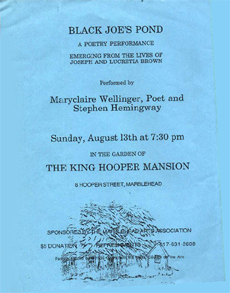

| MC READING AT HARVARD SPRING POETRY FESTIVAL 1997 |
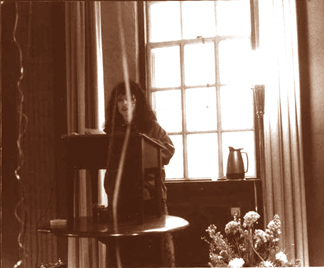
|
| PHOTO BY MARK J. FISHER |
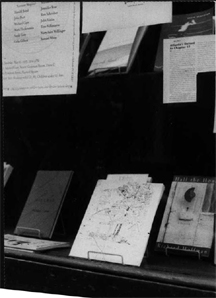
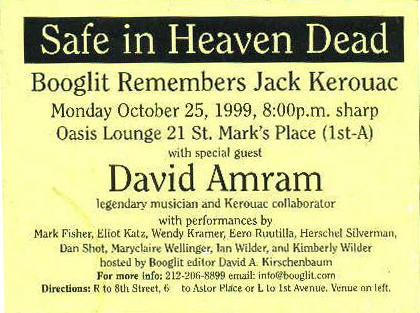
Publication Herstory of "Black Joe's Pond" by Rosewater Press
with Acknowledgements
Over the past 10 years, via Rosewater Press, I have published a new edition of the chapbook each time I gave a major reading. Given the recent disturbing experience I have had with theft of intellectual property, in this case, a kind of misappropriation of the subject of my major work of art, I am convinced even more that it's important for writers and poets and artists -- beyond copyrighting -- to archive their work, and to carefully document their sources. With "Black Joe's Pond", this important information includes the dates and descriptions of the editions published by Rosewater Press of the chapbook. This will will show how the work has evolved over time. The details will be added soon -- this page is currently under construction.

Thursday, December 12, 2002
Sacred space

By Jeremy D. Goodwin / Staff Writer
Thursday, December 12, 2002
"Something happened there... that was really extraordinary and remarkable," Marblehead artist Maryclaire Wellinger says of an afternoon she spent at Black Joe's Pond in 1991, during which she says she was "cracked open."
Wellinger was spending time at the pond on an October afternoon, when a magnificent great blue heron descended near her and stood for several hours. She was possessed with a strong sense that the bird embodied the spirits of Joe Brown and his wife, Lucretia, who owned the property some 300 years before.
She left the place with a powerful desire to learn more about the locally famous proprietors of the nearby tavern, now a private home that is still marked as "Black Joe's Tavern."
"There's something very sacred about that pond," she says. "I started to think a lot about who the people were that had lived there, who provided a gathering place for the community of fisherfolk... I just became compelled to learn as much as I could about Lucretia and about Joseph."
Browns inspire book
One of the results of this epiphany is Wellinger's series of narrative poems about the Browns, printed as a chapbook under her own aegis as Rosewater Press. The chapbook features the poems as well as Wellinger's own watercolor paintings, along with partial reproductions of the deeds by which Joseph Brown purchased his land and Lucretia's last will and testament. At the center of the work is a painting of the great blue heron itself, pictured sailing regally over the pond.
This work was made possible by Wellinger's transformational experience at the pond, but not just in terms of subject matter. Before that experience, this longtime poet had never experimented with paints.
Her long moment with the great blue heron inspired vivid visions of Old Marblehead, which even this prolific wordsmith could not describe aptly with language.
"I started to have these incredibly vivid waking and sleeping visions that were so colorful," she remembers. "I just picked up a paint box, a children's watercolor paint box, because I just wasn't even satisfied with the words describing what I was seeing. That's how I learned to paint."
Reaching a wider audience
Although the visual aspect of her artistic exploration was inspired by visions of Gingerbread Hill in the 1700s and the whale hunts engaged in by Joseph Brown's parents on Martha's Vineyard, Wellinger's work has now reached a wider audience through her use of computer software and a mouse.
One of Wellinger's digital collage pieces is currently pictured on the cover of the Italian literary journal Bérénice, a key voice of the art movement known as "Ini."
The piece, a pastiche of 1950s-era pulp novels or comic books, shows the artist's face attached to a curvy, sexually suggestive female body, which is stretching in the doorway of a mobile home. Near the bottom of the piece is the subtitle, "THE UNCENSORED CONFESSIONS OF A SAILOR, POET, PAINTER."
Key motif
Although her work spans a variety of media, Wellinger says that the key motif in her art is "nature, memory and myth." She often manipulates familiar images, or places images in unusual contexts, to challenge the dominant assumptions generated by a society that is still largely defined by males.
One piece of digital collage shows a doll's face merged with the body of a muscular woman wearing a bikini, as an old-time airplane flies in the background. A painting of Mugford Street shows a ship moored on one of the roofs.
"I bear witness to the disenfranchised, to voices that somehow remained silent until now," she says.
In the poem "Iris: Messenger to the Gods," Wellinger re-imagines Zeus' daughter as the African-American Olympic runner Jackie Joyner Kersee, giving guidance to women receiving treatment for drug addiction. Part of the poem's subject matter was inspired by Wellinger's work rehabilitating patients in Lynn.
"In contrast to these women I was working with, she was like a goddess," Wellinger says of Kersee. "She was beautiful, she was strong, she could win gold medals. So she embodied Iris in real life. I'm always re-interpreting history and mythology from a female's perspective, and from the perspective of someone who is disenfranchised."
Making a connection
Wellinger sees her ultimate goal as achieving a moment of communication - between poet and reader, artist and viewer, or perhaps with a previously unrealized part of herself.
"I think that these poems allow us to make connections to 'the other'...each poem is an attempt at intimacy," she said. "Some artists and poems say that every poem is a self portrait. That may be true, but I think it's also an attempt at making connection."
Moments later, she encounters difficulty articulating an aspect of her vision and spontaneously breaks into verse to illustrate her point.
"I can only say it sometimes in poetry," she laughs. "That's my problem."

Performance Illustrates How Everyone is "Under One Canopy"
by George Derringer,
The Marblehead Reporter, February 25, 1993
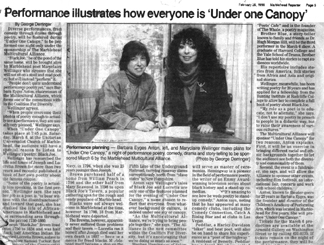 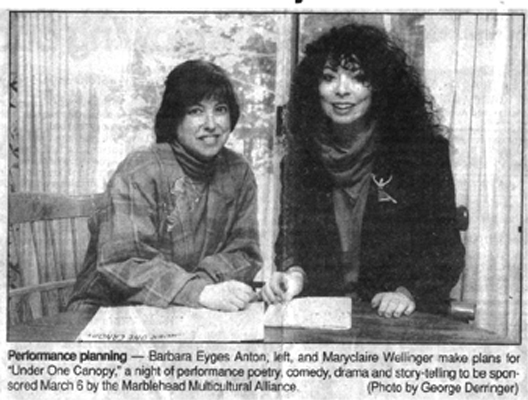



Ethics in the Arts
My friend and fellow poet, Peddlar, is a very talented performance-poet and one of his more well-know poems "What do I Want?" became the highlight of Peddlar's frequent gigs in the Cambridge and Boston area in the early '90s. Now Peddlar is a unique individual -- a true biker, a beat poet -- and no one who hears Peddlar perform forgets his dramatic, compelling performance poetry. Lo and behold, we were watching TV together, and what appears in a VISA commercial is this -- a biker riding down the escalator, holding a book of Gertrude Stein's work and out of his mouth come the words: "What do I want?". Peddlar also always tells his audience during his performance, that bikers without exception love Gertrude Stein and read her work. Now, how obscure is that? I mean, no one on Earth-- no straight 'citizen'-- has ever made a reference to bikers' reading habits, let alone would know that they like Gertrude Stein. So the writer of that VISA commercial had been in the audience one of those evenings Peddlar and I were performing together at Stone Soup or somewhere in Boston/Cambridge. It really happens. Unethical acts of intellectual theft do occur.
. (This is a draft of an article I am writing for publication -- to be continued) . . . . thank you for your patience --- mcw.)
|
|
|  |
